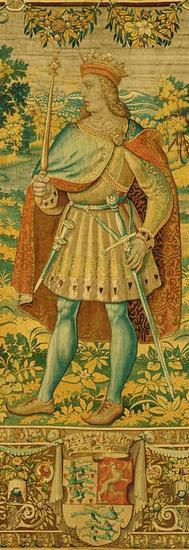<Back to Index>
- King of Denmark and Norway Olaf II Haakonsson, 1370
PAGE SPONSOR

Olaf II Haakonsson (1370 – 23 August 1387) was king of Denmark as Olaf II (1376 – 1387) and king of Norway as Olaf IV (1380 – 1387). Olaf was son of King Haakon VI of Norway and the grandson of King Magnus IV of Sweden. His mother was Queen Margaret I of Denmark which made him the grandson of King Valdemar IV of Denmark. In addition to his claim on the thrones of Denmark and later Norway, he was in the direct succession line to the throne of Sweden (but for the interposition of Albert of Mecklenburg).
He
became king of Denmark only five years old and when he later also
succeeded his father as king of Norway. For over 400 years that
followed, Norway would be ruled from Denmark, until its separation from
that country in 1814.
When his grandfather Valdemar IV of Denmark died, Olaf was just five years old. He was proclaimed King of Denmark by a Danehof in Slagelse the following year. His mother, Queen Margaret, was to serve as regent due to his young age. His proclamation included the title "true heir of Sweden" added at his mother's insistence since his grandfather had been king of Sweden until forced to abdicate. Olaf was hailed as king in Scania, including the towns controlled by the Hanseatic league since the Treaty of Stralsund in 1370. Queen Margaret signed a coronation charter on behalf of Olaf who was too young to rule until he came of age at fifteen. In the charter Olaf agreed to meet with the Danehof at least once a year and return properties his grandfather Valdemar IV had confiscated during his reign.
Olaf became King of Norway on his father's death in 1380. Even when Olaf reached his majority in 1385, his mother ruled through him. With his ascent to the Norwegian throne, Denmark and Norway were thus united in a personal union ruled from Denmark. Denmark and Norway would have the same king, with the exception of short interregnums, until Norway's independence in 1814.
Despite all the hope Margaret and the peoples of Denmark, Norway, and Sweden had for Olaf's future, they were never realized. He died unexpectedly in 1387 at age 17. He was buried at Sorø Abbey on the Danish island of Zealand where also his grandfather and, later, mother was buried. Rumors immediately arose that Olaf had been poisoned which gave rise to many years later to the story of "false Olaf".
Following his death at Falsterbohus, Olaf's mother was proclaimed "all powerful lady and mistress and the Kingdom of Denmark's Regent". Denmark had at the time no provision that enabled a woman to rule in her own right. The next year Norway proclaimed her Norway's "reigning queen". After the defeat and overthrow of King Albert in 1389 she was proclaimed "all powerful lady of Sweden". On 13 June 1397, she was able to unite the three Scandinavian kingdoms in a personal union under one crown for her successor Eric of Pomerania by the Kalmar Union.
After Olaf, no Norwegian king was to be born on Norwegian soil for more than 550 years, until prince Harald was born in 1937. Olaf's death was also the end of the male line of the Bjelbo dynasty in Sweden.
Prussian historian Johan von Posilge reported that in 1402 a "poor sick man came to the country and stayed near the village of Grudziądz. A group of merchants from Denmark asked him if he was not well known in Denmark, since he looked very much like the late King Olaf. The merchants left to find another who had seen the king and returned with him. When the newcomer saw the one they took for Olaf, he cried out, "My lord king!" Many people especially in Norway didn't believe that Olaf had died. They thought Queen Margaret had poisoned young Olaf to get him out of the way, so she could rule. According to the rumors, young Olaf hid himself and escaped. The news reached a merchant, Tyme von der Nelow, who took the man to Gdansk. The high born of the town welcomed Olaf as the rightful King of Denmark and Norway and gave him fine clothes and presents. A seal was made for him, and he wrote to Queen Margaret informing her that he was her son and demanded the restoration of his lands and titles. Queen Margaret wrote back saying that if he could prove himself her son, she would gladly accept him.
The Grand Master of the Teutonic Knights escorted the pretender to Kalmar to be interviewed by the Queen. As soon as the man arrived he was discovered to be an impostor. He could speak not a single word of Danish and on questioning admitted he was a Prussian who was the son of peasants: Adolph and Margaret from Eger. The false Olaf was taken to Lund in Scania. There he admitted to his breach against the monarchy and was condemned to be burned at the stake. The letters he wrote to Queen Margaret were hung around his neck and a mock crown placed on his head before he was lowered into the flames. His possessions were given to a monastery, and the queen had the false Olaf's seal destroyed. The Danish National Council released a detailed explanation of the real Olaf's death in 1387 to contradict the story that had spread around the Baltic.